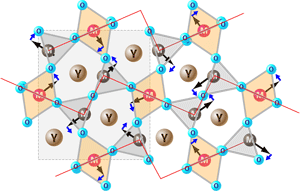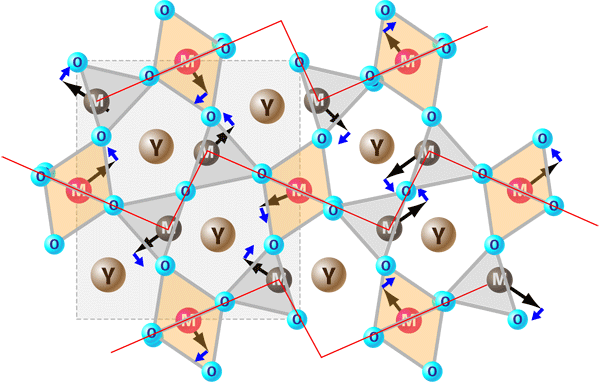Retrospective—Electromagnons offer the best of two worlds
This week, the Magnetism and Magnetic Materials Conference takes place in Scottsdale, Arizona. This article takes a look back on the discovery of electromagnons, and how it influenced the search for materials with coupled electric and magnetic properties.
Physical phenomena living in two worlds have long inspired scientists and popular culture alike. A good example is light, which consists of coupled electric and magnetic fields that oscillate in time. Light is the consummate example of electric and magnetic fields “working together.” In solid-state materials, however, it has proven difficult to discover and design materials with useful electromagnetic properties. The bulk of today’s device applications are based on materials where electric properties are controlled by electric fields, or where magnetic properties are controlled by magnetic fields.
Materials in which these properties are coupled would be advantageous because of how electric currents and magnetic fields are generated and measured. While it is easy to generate large electric fluctuations, the same facility does not exist for magnetic fields. From an applications standpoint, being able to store magnetic information with electric fields or currents and to manipulate domains in ferroelectrics—materials with long-range electric order—with magnetic fields would be particularly attractive. Dynamic magnetoelectric effects could enable ultrafast switching behavior in materials allowing the manipulation of electronic properties using short-pulsed lasers instead of ultrafast switching magnetic fields.
Recent developments in pursuit of this kind of control have occurred in multiferroics—materials that exhibit both magnetic and electric long-range order—which occasions us to revisit a paper by Andrei Sushkov of the University of Maryland, College Park and his collaborators. In 2007 they reported they were able to activate magnetic excitations (magnons) in manganese oxides using electric fields. These excitations, called “electromagnons,” were electric-dipole-active, that is, the electric fields stimulate the electric dipoles that affect the magnetic structure [1]. Since these magnetic excitations are hybrid magnetoelectric excitations that can be manipulated electrically and magnetically, they bridge the gap between electricity and magnetism in a solid-state system, and their discovery has launched an entire field of inquiry. While not the first observation of electromagnons, Sushkov et al.’s study made an important step toward identifying the origin for this new type of excitation.
To appreciate why the discovery of electromagnons caused so much excitement, consider that it is not straightforward to couple electric and magnetic degrees in freedom in an insulating material. Ferroelectrics are insulators where the charge fluctuations can be associated with so-called electric-dipole-active lattice vibrations. These excitations can drive phase transitions to ferroelectric, or charge-ordered phases. Magnetic fluctuations in insulators, on the other hand, are associated with localized magnetic moments, which are ordered at sufficiently low temperature and support coherent magnetic waves. Because the origin of the electro- and magneto-active excitations is very different, it is not easy to find coupled electromagnetic or magnetoelectric excitations in insulating materials. To make matters worse, the mechanism that leads to ferroelectricity in conventional ferroelectrics like , which should exhibit electric-dipole-active excitations, impedes the presence of magnetism.
Since the early efforts on classical ferroelectrics, research has rapidly progressed, and several different classes of multiferroics have been discovered [2,3], with coupled ferroelectric and magnetic degrees of freedom. While ferroelectricity in a classical ferroelectric like is driven by a hybridization of empty -shell orbitals on the transition-metal site with occupied shells on the oxygen sites, ferroelectricity in these new classes of materials arises from different mechanisms, such as lone-pair ions, topological effects of the chemical lattice, or magnetically driven effects in frustrated materials. Not long after the discovery of these new multiferroic materials, it was shown that such materials could, as suspected, support electromagnetic excitations in solid matter.
In 2006, Pimenov et al. [4] reported that, using terahertz light, they were able to excite spin waves, which they called electromagnons, in . They also showed the electromagnons could be suppressed by applying a magnetic field, directly demonstrating magnetic-field-tuned electric-dipole-active excitations. The understanding of these electromagnons was, however, tentative. For example, it was not clear whether the electromagnon is associated with the transition metal or rare-earth-metal ion magnetism in this material, thus leaving the origin of electromagnons as an open question. In , it is the magnetic interactions between the manganese ( ) ions that gives rise to ferroelectricity. But is also magnetic because of the electrons of the rare-earth-metal ions, so it was not clear whether these excitations arose purely from the transition-metal magnetism.
Published shortly afterwards, Sushkov et al.’s paper answered this question [1]. They observed the same effects in the multiferroic material , which contains no rare-earth-metal magnetism (Fig. 1), putting any doubts that the electromagnons were not associated with transition-metal magnetism to rest. Since these two ground-breaking studies, numerous observations of electromagnons in very different materials have been published. Electromagnons appear most commonly in magnetically induced ferroelectrics, including a number of spin spiral ferroelectrics.
It is now known that electromagnons can be in multiferroics where ferroelectricity does not arise from magnetic order. For example, these excitations occur in multiferroic , where ferroelectricity arises from the lone-pair mechanism and a low-pitch antiferromagnetic spiral does not form except at a much lower temperature [5]. Recently (and somewhat surprisingly), electromagnons were reported in the paraelectric phase of multiferroic materials. For example, electromagnons have been observed in a very different material with a very different electronic and physical structure: a conical-spin magnetically ordered phase of the paraelectric phase of the hexaferrite [6]. This is an exciting discovery, as it suggests that electric-dipole-active magnons can exist in nonmultiferroic materials, and that many magnetically ordered insulators with complex noncollinear magnetic structures may support electromagnon excitations.
Progress in this field is not just a matter of adding to the catalog of multiferroics exhibiting electromagnons. Initially, electromagnetic excitations were mostly observed at relatively low frequencies, where they were expected to drive the condensation of boson excitations associated with the phase transition. However, it has now been shown, contrary to expectation, that in rare-earth and electromagnetic excitations exist also at relatively high frequencies [7,8]. It has been suggested that at least some of the high-frequency excitations are two-magnon excitations, and these excitations are strongly coupled to some of the phonons in that energy range. The prospect of multiparticle magnon states that couple strongly to the lattice can lead to novel strongly correlated effects in these materials and other unusual interactions.
What sets the time scale of magnetoelectric switching in multiferroics is also an exciting open question. A recent theoretical study [9] predicts that electromagnons can be used to switch ferroelectric polarization in rare-earth manganites at a picosecond time scale using terahertz optical pulses. This would be due to the dynamic magnetoelectric effects that are larger than the spin-orbit interactions, leading to static magnetoelectric effects. Recent studies on suggest, however, that the switching time scale is considerably longer, in the millisecond range [10]. This time scale is much longer than what would be expected even if the dynamic magnetoelectric effects in this material were completely governed by spin-orbit interactions and not by symmetric exchange as in the rare-earth manganites.
Since the publication of Sushkov et al.’s work [1], the study of electromagnons and the multiferroics in which they appear has opened up a new field of research that continues to surprise. The challenge of finding materials that tick all the boxes of desirable features—abundance, operating temperatures, and controllability of magnetic and electrical switching—ensures exciting new discoveries for years to come.
References
- A.B. Sushkov, R. Valdés Aguilar, S. Park, S-W. Cheong, and H. D. Drew, Phys. Rev. Lett. 98, 027202 (2007)
- S.-W. Cheong and M. Mostovoy, Nature Mater. 6, 13 (2007)
- D. Khomskii, Physics 2, 20 (2009); see also http://physics.aps.org/articles/v2/20.
- A. Pimenov, A. A. Mukhin, V. Yu. Ivanov, V. D. Travkin, A. M. Balbashov, and A. Loidl, Nature Phys. 2, 97 (2006)
- M. Cazayous, Y. Gallais, A. Sacuto, R. de Sousa, D. Lebeugle and D. Colson, Phys. Rev. Lett. 101, 037601 (2008)
- N. Kida, D. Okuyama, S. Ishiwata, Y. Taguchi, R. Shimano, K. Iwasa, T. Arima, and Y. Tokura, Phys. Rev B 80, 220406 (2009)
- Y. Takahashi, N. Kida, Y. Yamasaki, J. Fujioka, T. Arima, R. Shimano, S. Miyahara, M. Mochizuki, N. Furukawa, and Y. Tokura, Phys. Rev. Lett. 101, 187201 (2008)
- A. M. Shuvaev, F. Mayr, A. Loidl, A. A. Mukhin, and A. Pimenov, Eur. Phys. J. B 80, 351 (2011)
- M. Mochizuki and N. Nagaosa, Phys. Rev. Lett. 105, 147202 (2010)
- T. Hoffmann, P. Thielen, P. Becker, L. Bohaty, and M. Fiebig, arXiv:1103.2066
- J. H. Kim, M. A. van der Vegte, A. Scaramucci, S. Artyukhin, J.-H. Chung, S. Park, S-W. Cheong, M. Mostovoy, and S.-H. Lee, Phys. Rev. Lett. 107, 097401 (2011)





